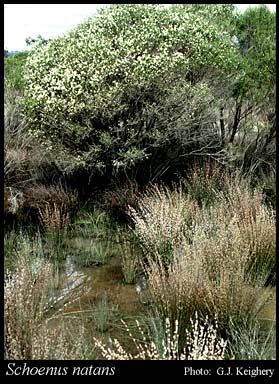- Reference
- Mem.Fam.Rhamnees p61 (1826)
- Name Status
- Current







Scientific Description
Family Rhamnaceae.
Habit and leaf form. Trees, or shrubs, or lianas (rarely). ‘Normal’ plants. Leaves well developed. Plants with roots; non-succulent; spiny, or unarmed; autotrophic. To 2 m high. Self supporting, or climbing. Not heterophyllous. Leaves medium-sized; alternate, or opposite; with blades; leathery; petiolate; ‘usually with minute glands’; simple; not peltate. Leaf blades entire; flat; broadly ovate (in WA); pinnately veined; cordate, or rounded at the base. Mature leaf blades adaxially glabrous (or scattered hairs on the veins); abaxially glabrous (or scattered hairs on the veins). Leaves with stipules. Stipules scaly; caducous. Leaf blade margins serrate; flat. Leaf anatomy. Hairs present, or absent.
Reproductive type, pollination. Fertile flowers hermaphrodite. Unisexual flowers absent. Plants hermaphrodite.
Inflorescence and flower features. Flowers aggregated in ‘inflorescences’. Inflorescence many-flowered. Flowers in clusters. Inflorescences simple; axillary. Flowers pedicellate; minute; regular; 5 merous; cyclic; tetracyclic. Free hypanthium present. Perianth with distinct calyx and corolla; 10; 2 -whorled; isomerous. Calyx present; 5; 1 -whorled; gamosepalous; lobed; hairy (outside), or glabrous; valvate; regular; green, or yellow. Calyx lobes ovate. Epicalyx absent. Corolla present; 5; 1 -whorled; alternating with the calyx; polypetalous; regular. Petals hooded. Androecium present. Fertile stamens present. Androecial members definite in number. Androecium 5. Androecial members adnate (to the base of the sepals); free of the gynoecium; free of one another; 1 -whorled. Stamens 5; all more or less similar in shape; isomerous with the perianth; alternisepalous; filantherous. Anthers separate from one another; dehiscing via longitudinal slits; bilocular; tetrasporangiate. Fertile gynoecium present. Gynoecium 3 carpelled. The pistil 1 celled. Carpels reduced in number relative to the perianth. Gynoecium syncarpous; synstylovarious; superior. Ovary plurilocular; 3 locular. Gynoecium stylate. Styles 1; sometimes 3-branched; apical. Stigmas 3 - lobed. Ovules 1 per locule (in WA); ascending; anatropous.
Fruit and seed features. Fruit aerial; 7–10 mm long; a schizocarp. Dispersal unit the seed, or the fruit. Seeds 1 per locule.
Geography, cytology, number of species. Native of Australia. Not endemic to Australia. Australian states and territories: Western Australia, Northern Territory, and Queensland. Northern Botanical Province. A genus of ca 30 species; 1 species in Western Australia; C. asiatica (L.) Brongn.; 1 endemic to Western Australia.